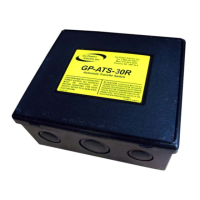Go Power! TS-30
Owner’s Manual
7
you experience general low voltage conditions, remember that brownouts can be
harmful to most appliances. A better alternative might be to utilize the generator until
park voltage conditions improve.
4.3 LOCALIZED LOW VOLTAGE
Low voltage conditions can be caused by specific situations such as an additional
cord, which is too long and too small for the load. Do not attempt to extend the RV
power cord by using a 16-gauge 100-foot extension cord, or any cord not rated for
an RV-size load. A localized low voltage condition will result when a load is turned
on which is larger than that which the cord is designed for. As soon as the RV tries
to draw more current than the amount for which the cord is rated, the voltage will fall
within the length of the cord, and the RV will experience low voltage. This is
especially noticeable during in rush current situations such as an air conditioner
start-up.
This affects contactor-based transfer switches. The compressor will try to start; the
voltage will drop, which will cause the contactor to drop out, at which point the
voltage will rise to the pre-in rush level. The contacts will chatter when the A/C
compressor kicks in, however the voltage may read normal. Most meters are not
fast enough to record this voltage drop. You can test for low voltage readings during
this inrush cycle by reading voltage at the contactor terminals while manually
holding the contactor plunger down in its closed position. This will override the
chattering condition and the meter will have time to register the reduced voltage. If
this condition exists, identify and correct the low voltage situation before proceeding
further.
4.4 PHYSICAL INTERFERENCE
Some transfer switch models have wiring connections made by wire nuts on 6″
leads. Occasionally on these models, the wiring connections will get folded into the
can in such a manner that the wiring will interfere with the physical operation of the
relay. Visually inspect for free operation of the relay(s).
4.5 TIME DELAY BYPASS SWITCH
The time delay function in the control module on some models may be bypassed.
Relay-based transfer switches have incorporated into the control module board a
small switch, which allows the technician to activate or bypass the time delay. The
time delay is necessary during generator start-up so that the generator does not
have to start under load; the delay is not necessary for power cords or inverters.
Therefore in transfer switch operation where the module is controlling a supply other
than a generator, the delay switch should be set to the bypass (ON) position. This
will allow instantaneous switching. Another time for bypassing the delay is during
diagnostic and troubleshooting efforts; if bypassing the delay causes the switch to
work when it otherwise won’t, then the time delay has malfunctioned and the board
should be replaced. To bypass the time delay, locate the switch on the end of the
circuit board and select the position on the switch marked ON. Time delay bypass is
now activated, and transfer will be instantaneous.
4.6 FAILED TIME DELAY CONTROL MODULE
It is possible for a voltage spike, etc. to cause the time delay module to fail: if this
happens the switch will no longer transfer. Transfer Switch models have a
diagnostic LED mounted on the control module circuit board. If the module is
receiving 120 VAC input and is operating properly, the LED will be lit. This means
the control module has timed for the 20-30 second delay and is now providing
power to the coil on the relay. If the module input is energized and the LED does not

